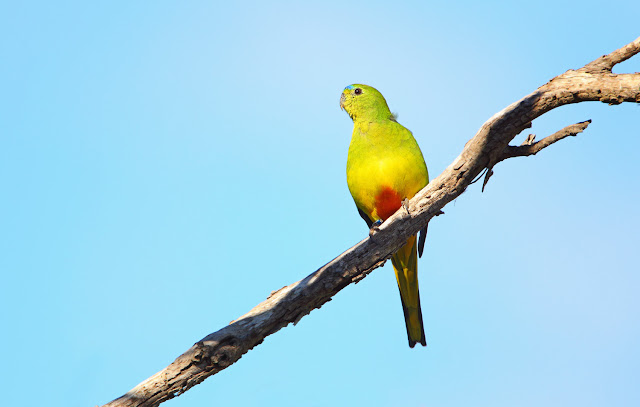One of our greatest writers has written a novel with a pivotal role for a surprising character: Neophema chrysogaster, the Orange-bellied Parrot.
Richard Flanagan's The Living Sea of Waking Dreams is a moving meditation
on the death of a matriarch and of our planet herself.
The Tasmanian writer - described as "one of [the world's] greatest living novelists" - has won the Man Booker Prize and numerous Australian literary
awards.
Orange-bellied Parrots play their role towards the end of the story, in which 87-year-old Francie
lies dying in a Hobart hospital. Her children collude to continue active treatment,
even though her quality of life is nil.
In her weakened state, Francie hallucinates, while daughter Anna begins
to lose body parts – for real. First a finger, then a knee, a breast and an eye disappear, in an allegory
of species extinction. Nobody notices, much as our flora and fauna have begun
to disappear with a similar lack of fanfare.
Anna meets an OBP researcher and ends up volunteering at Melaleuca,
assigned to count the birds. Unlike the reality, none arrive.
Flanagan creates wretched despair around this but whimsy, too.
A four-seater plane bearing Anna to the Southwest is described as “like a
f***ing airborne Hillman Minx” flown by “a disturbingly young pilot” who
resembles a “high school truant”.
(Apologies to the company that flies light planes to Melaleuca but their pilots really are, for the most part, both capable and young.)
In this vast country - the breeding grounds of the OBP - Anna sees everything with fresh language: the tiny shadow of the plane “tracks across the
forests far below, a drop of spilt ink rolling across the page”.
Few writers have better conveyed the emotion and drama of the “immense
wild vista” of the Southwest Wilderness. Port Davey - a large inland harbour - is "surrounded by trackless hills of heath and buttongrass ceding to tea tree woods
and rainforest, a world waving green in all its colours”.
 |
| These beautiful feathers adorn the book's hardcovers, a delightful surprise beneath the dustjacket |
Finally, a single OBP does arrive and settles into a nestbox. This is also true; nestboxes have been provided for OBPs since the 1980s. Mysteriously, though no male appears, she seems about to lay her eggs.
“The tiny bird, green as hope” fluffs up in “a controlled shudder” and
dropping back down, settles “her orange belly into a nesting position”. Hope has arrived with this bright green parrot, whose fate has been in the balance for 40 years.
The generative power of the female OBP and of human women is contrasted with the slow, terrible death of poor Francie. Everything is done to try to save her yet, like the earth, her decline is unstoppable.
Plastic pollution, climate change, species extinction and, above all,
the disastrous summer fires of 2019/20 – are constantly foregrounded. Yet the book is also about an ordinary family failing to come to terms with death.
The mystical weaves in and out of the everyday. Words flow like a Tasmanian rapid and punctuation sometimes ceases.
But on every page is writing from an observer pained
by, yet in love with, this troubled planet.
If you too love the wild places, read The
Living Sea of Waking Dreams and start talking about the issues. Ponder your own choices.
Flanagan’s conservation
message is an urgent call to arms, matched only by his exquisite language and dazzling originality.
 |
| Dustjacket |









.jpg)











